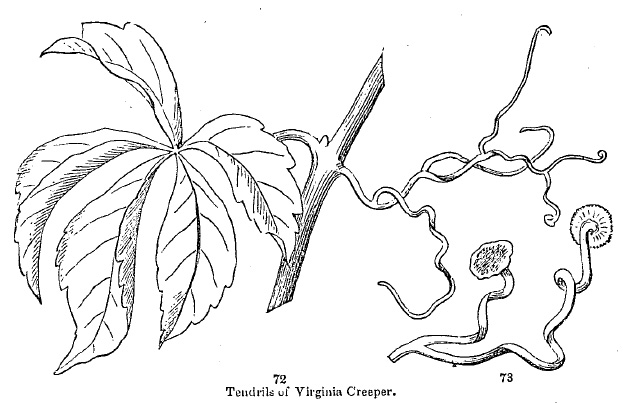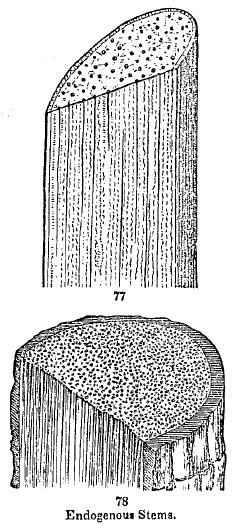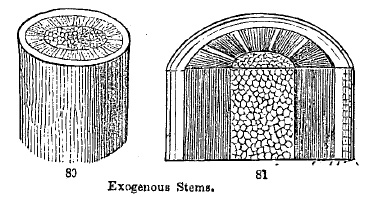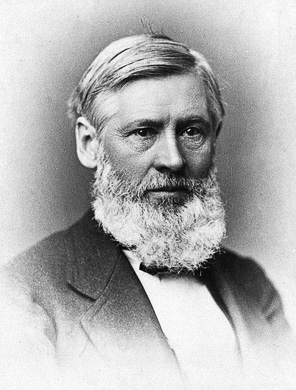BOTANY FOR YOUNG PEOPLE AND COMMON SCHOOLS
How Plants Grow
A Simple Introduction to Structural Botany
by Asa Gray
Originally published in 1858 and now in the public domain.
CHAPTER I.
HOW PLANTS GROW, AND WHAT THEIR PARTS OR ORGANS ARE.
SECTION IV. -- Different Forms or Kinds of Roots, Stems, and Leaves (page 2 of 3).
81. The Organs of Vegetation, or those that have to do with the life and growth of a plant, are only three, Root, Stem, and Leaf.
And the plan upon which plants are made is simple enough. So simple and so few are the kinds of parts that one would hardly expect plants to exhibit the almost endless and ever-pleasing diversity they do. This diversity is owing to the wonderful variety of forms under which, without losing their proper nature, each of these three organs may appear.
82. The study of the different shapes and appearances which the same organ takes in different plants, or in different parts of the same plant, comparing them with one another, is called Morphology and is one of the most interesting parts of Botany.
But in this book for young beginners, we have only room to notice the commonest forms, and those very briefly, although sufficiently to enable students to study all common plants and understand botanical descriptions. Those who would learn more of the structure and morphology of plants should study the Lessons in Botany.
1. Of Roots. CLICK HERE
§ 2. Of Stems.
90. Forms or Kinds of Stems. Differences in the size and consistence of stems, such as distinguish plants into herbs, shrubs, and trees, have already been noticed in paragraphs 64, 65, and 66. A stem is
Herbaceous, when it belongs to an herb, that is, has very little wood in its composition, and does not live over winter above ground;
Shrubby, when it belongs to a shrub, or is woody;
Arboreous or Arborescent, when the plant is a tree, or like a tree; that is, when it is tall and grows by a single trunk.
91. The peculiar straw-stem of a grass or grain is named a Culm. It is generally hollow, except at the joints, which are hard and solid; but in Indian Corn, Sugar-Cane, and some other Grasses, it is not at all hollow.
92. As to the mode of growth or the direction it takes in growing, the stem is
Erect or Upright, when it grows directly upwards, or nearly so;
Ascending, when it rises upwards at first in a slanting direction;
Declined or Reclined, when turned or bent over to one side;
Decumbent, when the lower part reclines on the ground, as if too weak to stand, but the end turns upwards more or less;
Procumbent or Trailing, when the whole stem trails along the ground;
Prostrate, when it naturally lies flat on the ground;
Creeping or Running, when a trailing or prostrate stem strikes root along its lower side, where it rests on the ground;
Climbing, where it rises by laying hold of other objects for support; either by tendrils, as in the Pea, Gourd, and Grape-Vine, or by twisting its leafstalks around the supporting body, as in the Virgin's Bower; or by rootlets acting as holdfasts, as in the Ivy and Trumpet-Creeper (86);
Twining, when stems rise by coiling themselves spirally around any support, as in the Morning-Glory (Fig. 4), Hop, and Bean.
93. Several sorts of branches are different enough from the common to have particular names. Indeed, some are so different that they would not be taken for branches without considerable study. Such, for instance, as
94. Thorns or Spines. Most of these are imperfect, leafless, hardened, stunted branches, tapering to a point. That they are branches is evident in the Hawthorn and similar trees, from their arising from the axil of leaves, as branches do. And on Pear-trees and Plum-trees many shoots may be found which begin as a leafy branch but taper off into a thorn.
Prickles, such as those on the stems of Roses and Brambles, must not be confounded with thorns. These are growths from the bark (like hairs or bristles, only stouter), and peel off with it; while thorns are connected with the wood.

95. Tendrils, such as those of the Grape-Vine, Virginia Creeper (Fig. 72), and the Melon or Squash, are very slender, leafless branches, used to enable certain plants to climb.
They grow out straight or nearly so until they reach some neighboring support, such as a stem, when the end hooks around it to secure a hold, and the whole tendril then shortens itself by coiling up spirally, so drawing the growing shoot nearer to the supporting object.
When the Virginia Creeper climbs the side of a building, the face of a rock, or the smooth bark of a tree, which the tendrils cannot lay hold of in the usual way, their tips expand into a flat plate (as shown in Fig. 73, the ends of a tendril magnified), which adheres very firmly to the surface. This enables the plant to climb up a smooth surface by tendrils, just as the Ivy and Trumpet-Creeper climb by rootlets.
96. Peduncles or Flower-stalks are a kind of branches, or stems, as is clear from their situation. They are either a continuation of the stem, as in the Lily of the Valley and the Chalcedonian Lily, represented on the first page; or else they rise out of the axil of a leaf, as in the Morning-Glory (Fig. 4).
Plainly, whatever comes from the axil of a leaf must be of the nature of a branch. So
97. Buds, that is axillary buds, are undeveloped branches, as already explained in paragraphs 55 to 58.
98. The following kinds of branches are all connected with the ground in some way, and most of them act in such a way as to make new plants.

99. A Stolon is a branch which reclines on the ground, or bends over to it and strikes root (Fig. 74).
Currant-bushes spread naturally by stolons, and so does White Clover.
The gardener imitates the process where it does not naturally occur, or facilitates it where it does, by bending branches to the ground, and pinning them down, when they strike root where they are covered by the soil, and then the branch, having leaves and roots of its own, may be separated as an independent plant. In this way the gardener multiplies many plants by layering which he cannot so readily propagate by seed.
100.A Runner (Fig. 74) is a very slender, thread-like, leafless stolon, much like a tendril, lying on the ground, and rooting and budding at the point, so giving rise to a new plant at some distance from the parent, and connected with it during the first year. But the runner dies in winter and leaves the young plant independent.
The Strawberry-plant affords the most familiar illustration of runners. Each plant or offshoot, as soon as established, sends out runners of its own, which make new plants at their tip. In this way a single Strawberry-plant produces a numerous progeny in the course of the summer and establishes them at convenient distances all around.
101. A Sucker (Fig. 74) is a branch which springs from a parent stem under ground, where it makes roots of its own, while farther on it rises above ground into a leafy stem, and becomes an independent plant whenever the connection with the parent stem dies or is cut off.
It is by suckers that Rose and Raspberry bushes multiply and spread so "by the root," as is generally said. But that these subterranean shoots are stems, and not roots (though they produce roots), will plainly appear by uncovering them.
102. An Offset is a short branch, next the ground or below its surface, like a short stolon or sucker, bearing a tuft of leaves at the end, and taking root where this rests on the soil, as in the Houseleek (Fig. 65), where one plant will soon produce a cluster of young plants or offsets all around it.

103. A Rootstock is any kind of horizontal stem or branch growing under ground.
Slender rootstocks occur in the subterranean part of the suckers of Roses, of Peppermint, or of Canada Thistle, and of Quick-Grass or Couch-Grass (Fig. 75), which spreads so widely, and becomes so troublesome to farmers.
They are well distinguished from roots by the leaves which they bear at every joint, in the form of scales, and by the buds which they produce, one in the axil of each scale. These buds, which are very tenacious of life, are what renders the plant so exceedingly difficult to destroy. For ploughing and hoeing only cut up the rootstock into pieces, each with a tuft of roots ready formed and with a bud to each joint, all the more ready to grow for the division. So that the attempt to destroy Quick-Grass by cutting it up by the roots (as these shoots are called), unless the pieces are carefully taken out of the soil, is apt to produce many active plants in place of one.
104. Thickened or fleshy rootstocks, such as those of Solomon's Seal (Fig. 63) and Iris (Fig. 64), have already been illustrated (76).
105. A Tuber is a rootstock thickened at the end, as already explained in the Potato and Ground Artichoke (74, 75, Fig. 59, 60). The eyes of a tuber are lively buds, well supplied with nourishment for their growth.

106. A Corm or Solid Bulb, as of Gladiolus and Crocus (Fig. 76), is a sort of rounded tuber. If well covered with thick scales it would become
107. A Bulb. This is a (mostly subterranean) stem, so short as to be only a flat plate, producing roots from its lower surface and above covered with thickened scales, as was fully explained in the last section (77).
108. Bulbs are scaly, as in the Lily (Fig. 66), when the scales are narrow; or coated, as an onion, when the scales enwrap each other, and form coats.
109. Bulblets are little bulbs, or fleshy buds, formed in the axils of leaves above ground, as in the Bulb-bearing Lily. Or in some Leeks and Onions they take the place of flower-buds. Falling off, they take root and grow into new plants.
110. The Internal Structure of Stems. Plants are composed of two kinds of material, namely, Cellular Tissue and Wood.
The former makes the softer, fleshy, and pithy parts; the latter forms the harder, fibrous, or woody parts. The stems of herbs contain little wood, and much cellular tissue; those of shrubs and trees abound in the woody part.
111. There are two great classes of stems which differ in the way the woody part is arranged in the cellular tissue. They are named the Exogenous, and the Endogenous.
112. For examples of the first class we may take a Bean-stalk, a stem of Flax, Sunflower, or the like, among herbs, and for woody stems any common stick of wood. For examples of the second class take an Asparagus-shoot or a Cornstalk, and in trees a Palm-stem.
These names express the different ways in which the two kinds grow in thickness when they live more than one year. But the difference between the two is almost as apparent the first year, and in the stems of herbs; which lasts only one year.


113. The Endogenous Stem. Endogenous means "inside-growing."
Fig. 77 shows an Endogenous stem in a Cornstalk, both in a cross-section, at the top, and also split down lengthwise. The peculiarity is that the wood is all in separate threads or bundles of fibres running lengthwise, and scattered among the cellular tissue throughout the whole thickness of the stem.
On the cross-section their cut ends appear as so many dots; in the slice lengthwise they show themselves to be threads or fibres of wood.
Fig. 78 is a similar view of a Palm-stem (namely, of our Carolina Palmetto, of which whole trees are represented in Fig. 79).
It shows the endogenous plan in a stem several years old. Here the bundles of wood are merely increased very much in number, new threads having been formed throughout intermixed with the old, and any increase in diameter that has taken place is from a general distention or enlargement of the whole.
Such stems may well enough be called inside-growers, because their wood increases in amount, as they grow older, by the formation of new threads or fibres of wood within or among the old.
114. Moreover, endogenous stems are apt to make few or no branches.
Asparagus is the only common example, to the contrary, that branches freely. But the stalks of Corn and other grain, and those of Lilies (Fig. 1, 2) and the like, seldom branch until they come to flower; and Palms are trees of this sort, with perfectly simple or branchless trunks, rising like columns, and crowned with a tuft of conspicuous and peculiar foliage, which all comes from the continued growth of a terminal bud.
115. The Exogenous Stem is the kind we are familiar with in ordinary wood. But it may be observed in the greater part of our herbs as well. It differs from the other class, even at the beginning, by the wood all occupying a certain part of the stem, and by its woody bundles soon appearing to run together into a solid layer.
This layer of wood, whether much or little, is always situated around a central part, or pith, which has no wood in it, being pure cellular tissue, and is itself surrounded by a bark which is mainly or at first entirely cellular tissue.
Thus a slice across an exogenous stem always has a separate cellular part, as bark, on the circumference, then a ring of wood, and in the centre a pith, as is seen in Fig. 80, representing a piece of Flax-stem magnified; and also in Fig. 81, which shows the same structure in a woody stem, namely, in a shoot of Maple of a year old, cut both crosswise and lengthwise.

116. The difference becomes still more marked in stems more than one year old.
During the second year a new layer of wood is formed outside of the first one, between it and the bark; the third year, another layer outside of the second, and so on, a new layer being formed each year outside of that of the year before.
The increase is all on the surface and buries the older wood deeper and deeper in the trunk. For this reason such stems are said to be exogenous or outside-growing (from two Greek words which mean just this), a new layer being added to the wood on the outside each year as long as the tree or shrub lives.
And so the oldest wood, or Heart-wood, is always in the centre, and the newest and freshest, the Sap-wood, at the circumference just beneath the bark.
117. The heart-wood is dead, or soon becomes so. The sap-wood is the only active part, and this, with the inner bark, which is renewed from its inner face every year, is all of the trunk that is concerned in the life and growth of the tree.
118. Plants with exogenous or outside-growing stems, especially those that live year after year, almost always branch freely.
All common shrubs and trees of the exogenous class make a new set of branches every year, and so present an appearance very different from that of most of those of the endogenous or inside-growing class.
3. Of Leaves. CLICK HERE
Analysis of the Section.
90. Forms or kinds of stem; herbaceous, shrubby, arboreous. 91. Culm or straw-stem. 91. Culm or straw-stem. 92. Directions or positions of stems. 93. Peculiar sorts. 94. Thorns or Spines, how shown to be branches; Prickles. 95. Tendrils. 96. Peduncles or Flower-stalks. 97. Buds. 98. Branches connected with the ground. 99. Stolons. 100. Runners. 101. Suckers. 102. Offsets. 103. Rootstocks. 104. Fleshy Rootstocks. 105. Tubers. 106. Corms. 107. Bulbs. 108. Scaly and coated. 109. Bulblets.
110. Internal Structure of Stems; Cellular Tissue; Wood. 111. The two classes of stems. 112. Examples, both in herbs and trees. 113. Endogenous stem; how its wood is arranged. 114. External appearance and growth. 115. Exogenous stem; common wood. 116. How it increases in diameter year after year; Sap-wood and Heart-wood. 117. The latter dead, the former annually renewed. 118. External appearance and mode of growth.

